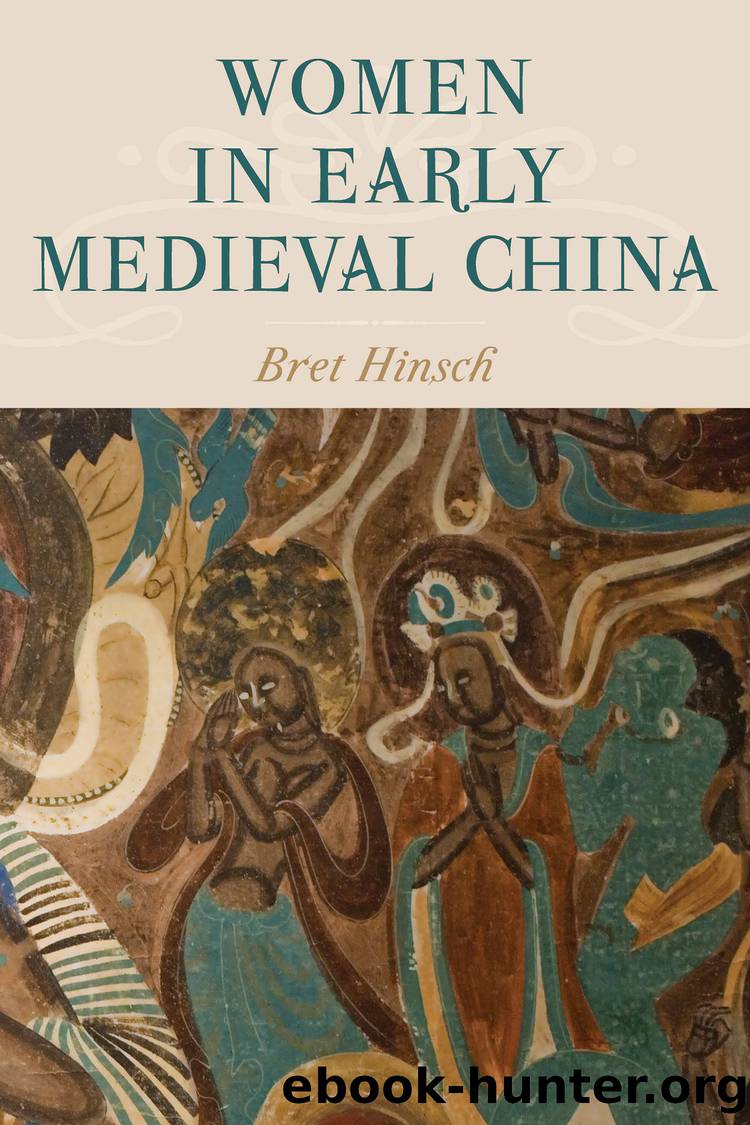Women in Early Medieval China by Hinsch Bret;

Author:Hinsch, Bret; [Hinsch, Bret]
Language: eng
Format: epub
Publisher: Rowman & Littlefield Unlimited Model
Published: 2018-08-23T00:00:00+00:00
8
Ideals
Han dynasty writers and artists portrayed the ideal woman as a moral paragon, a belief that endured even after that dynasty ended. This image can be seen in a series of wall paintings in the tomb of Sima Jinlong (d. 484) that depicts male and female role models. Alongside pictures of rulers, generals, high ministers, and other great men, the artist painted virtuous ancient queens and women renowned for wisdom or self-sacrifice.1 This cycle of didactic portraits replicates the traditional view of women, seeing them through the lens of ethics and politics, even though the world that produced these stereotypes had crumbled long before.
Newer images of women had more relevance to the changed circumstances marking the age of disunion. The disorienting chaos of this era stimulated people to question basic verities, including assumptions about gender, giving rise to new, original, and sometimes contentious images of womanhood. Some of these ideas had currency for a short time while others endured to affect subsequent eras. The surge in religious faith led some believers to imagine the model woman as a goddess. One epitaph compares a deceased woman to the goddesses of the Xiang and Luo rivers.2 Overall, however, female role models were rarely so simplistic. Society had become extremely diverse, and the creative class had to come to grips with contradictory influences. Pastoral cultures introduced images of lively and brave women. Yet Confucian influence lingered, perpetuating the belief that women should be submissive and passive. Presented with conflicting gender norms, it was hard for men to know what they wanted from women, and even harder for women to understand how to be themselves.3
This era also saw the growth of a darker view of femininity. Men regarded menstrual blood with horror. They believed that the periodic discharge of menses renders a woman permanently unclean, however beautiful she might appear.4 Medical texts increasingly stressed the inherent pollution of the female body, portraying women as physically inferior to men in consequence. However, the female physique also harbored innate curative powers. Physicians used menstrual fluid as an ingredient in certain healing concoctions, apparently assuming that such a loathsome material could expel disease. Menses also allowed women to become powerful shamans and sorcerers. Ready access to potent menstrual blood allowed them to brew potions that could harm others. In sum, people saw the female body in contradictory ways, as beautiful yet dangerously polluting.
The mechanics of early medieval scholarship and intellectual discourse differed fundamentally from prior practices. The Han dynasty elite looked to ancient texts to understand and order their world, imposing intellectual and cultural conformity. Moreover, they assumed that the writers have a duty to serve the state.5 Working under the influence of Confucianism, Han authors made literature a tool of politics. As propriety discouraged the criticism of corruption or malfeasance, poets often ended up indiscriminately praising the flawed status quo.6
During the age of disunion, modes of writing changed in significant ways.7 Poets still wrote rhapsodies (fu), but they redirected their output to new ends.8 Poetry became more critical and self-conscious.
Download
This site does not store any files on its server. We only index and link to content provided by other sites. Please contact the content providers to delete copyright contents if any and email us, we'll remove relevant links or contents immediately.
| Central Asia | Southeast Asia |
| China | Hong Kong |
| India | Japan |
| Korea | Pakistan |
| Philippines | Russia |
The Rape of Nanking by Iris Chang(3518)
The Sympathizer by Viet Thanh Nguyen(3487)
World without end by Ken Follett(3008)
Ants Among Elephants by Sujatha Gidla(2925)
Blood and Sand by Alex Von Tunzelmann(2610)
Japanese Design by Patricia J. Graham(2558)
City of Djinns: a year in Delhi by William Dalrymple(2137)
Inglorious Empire by Shashi Tharoor(2102)
Foreign Devils on the Silk Road: The Search for the Lost Treasures of Central Asia by Peter Hopkirk(2056)
In Order to Live: A North Korean Girl's Journey to Freedom by Yeonmi Park(2055)
Tokyo by Rob Goss(2018)
India's Ancient Past by R.S. Sharma(1988)
India's biggest cover-up by Dhar Anuj(1986)
The Great Game: On Secret Service in High Asia by Peter Hopkirk(1962)
Tokyo Geek's Guide: Manga, Anime, Gaming, Cosplay, Toys, Idols & More - The Ultimate Guide to Japan's Otaku Culture by Simone Gianni(1947)
Goodbye Madame Butterfly(1937)
The Queen of Nothing by Holly Black(1757)
Living Silence in Burma by Christina Fink(1731)
Batik by Rudolf Smend(1722)
